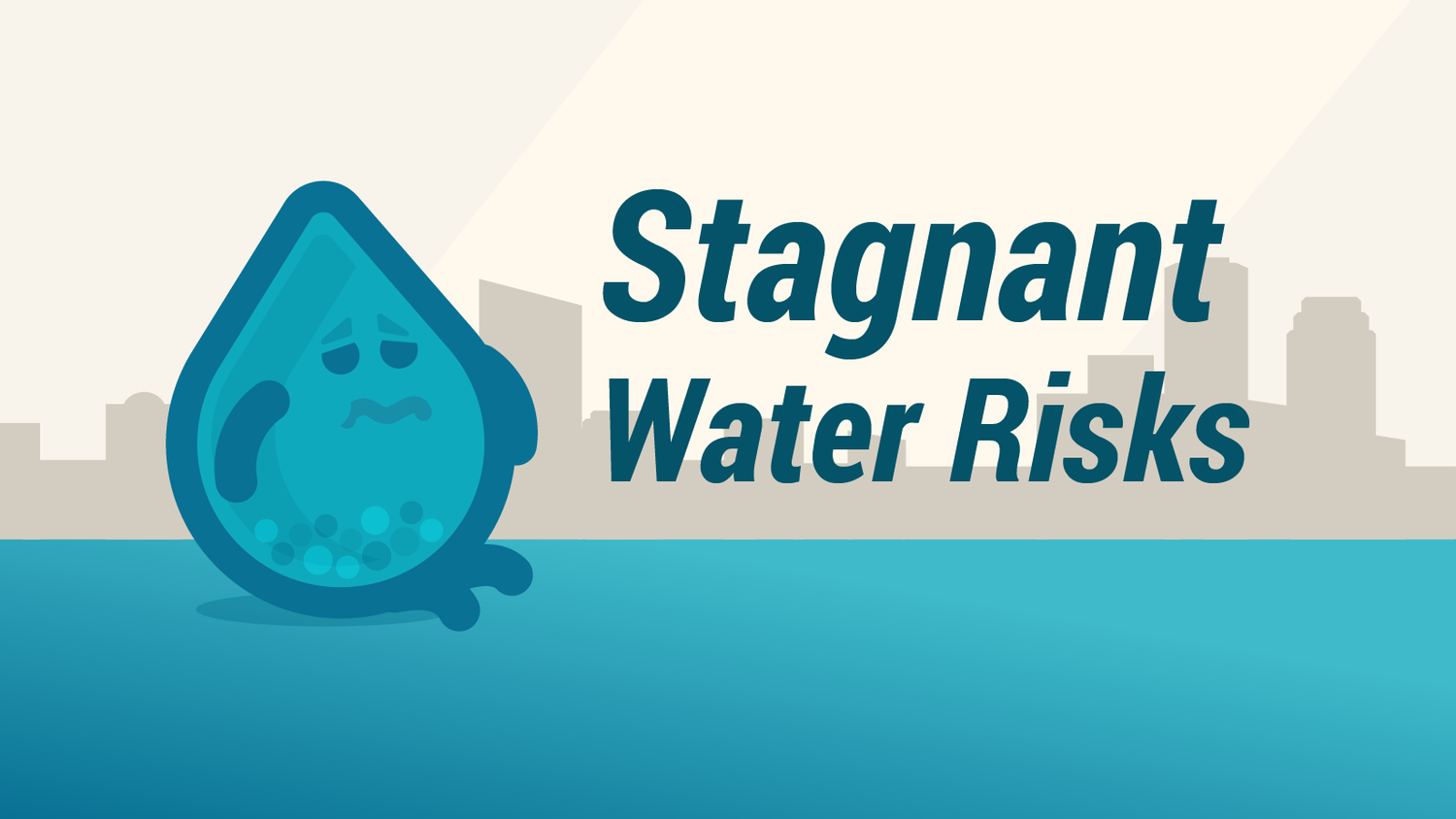
What Happens to Stagnant Water in a Vacant Building?
Our blog is written by real experts— not AI. Each guide is carefully reviewed and updated based on the latest research. Plus, with no affiliate links, you can count on unbiased insights you can trust.
From temporary shutdowns to seasonal occupancy, long periods of reduced water use can lead to a variety of potential hazards when turning the tap back on in a vacated building.
Stagnant water left in unused plumbing is a breeding ground for bacteria and contaminants like lead. Water quality issues can develop within just a few days at individual faucets. Even devices normally used to improve water quality—like filters, heaters, and softeners—can create health risks if not maintained during periods of stagnancy. While there is currently no standard for safely reopening a building, flushing fixtures has been a recommended practice before using inactive plumbing.
Why Does Bacteria Grow in Unused Plumbing?
Stagnant water can spread the growth of Legionella and other biofilm forming bacteria (like Pseudomonas and nontuberculous mycobacteria). Legionella infects people who breathe in droplets or steam from contaminated faucets, causing a pneumonia-like illness.
Legionnaires’ disease, the illness caused by Legionella, kills more people in the U.S. than any other waterborne pathogen.
Plumbing Conditions That Cause Bacteria Growth
- Reduced water temperatures (68 to 120 degrees Fahrenheit) in empty buildings promote bacteria growth.
- Stagnant water causes sediment and corrosion in pipes, which promotes biofilm by providing food for bacteria.
- Disinfectants added during water treatment, like chlorine, dissipate over time, allowing leftover bacteria in stagnant water to spread inside pipes, fixtures, and plumbing devices.
How Long Does it Take for Bacteria to Grow in Plumbing?
If present, Legionella can grow significantly within weeks or months of inactivity, depending on factors like water heater temperatures, residual disinfectant concentrations, and preexisting Legionella colonies. Microbes like coliform, pseudomonads and other heterotrophic bacteria are prone to regrowth.
It’s also important to note that, in addition to pipes, point-of-use faucet filters and water storage units are susceptible to bacteria.
Even Temporary Closure Can Cause Plumbing Corrosion
Stagnant water can also cause harmful metals to dissolve into your plumbing.
Sitting water releases dissolved oxygen and, in turn, oxidizes metals and promotes the growth of bacteria that scavenge the metal surfaces of pipes for energy. Over time this mix of bacteria, oxidation, and other water quality conditions (like acidity) leads to corrosion, causing metals—like lead—to dissolve into the building’s water system.
Buildings that have lead, brass, or copper pipes, solder, or fixtures are especially at risk of corrosion.
Lead and copper contamination are linked to health hazards like neurological disorders, heart disease, and digestive distress. Buildings constructed before the 1986 ban on lead plumbing are more likely to contain lead pipes and solder. Fixtures and faucets purchased before 1997 can contain up to 8% lead, and only faucets purchased after 2014 are required to contain no more than 0.25% lead.
Is It Safe To Restart Plumbing in Vacant Buildings?
As noted by Purdue University Center for Plumbing Safety, there is no government or industry standard for how to restart plumbing in large buildings that have been vacant for long periods of time.
While guidance exists for cases like seasonal hotels, they don’t explicitly deal with how to handle long bouts of stagnation in low-occupancy buildings.
In a study funded by the National Science Foundation, Purdue recommends flushing fixtures at least weekly.
Flushing calls for running water from the point-of-entry throughout the entire building’s water system, replacing all the old water.
The study recommends, at minimum, that the water used for flushing should have:
- High temperatures or disinfectant (to prevent bacteria growth)
- A corrosion control component
Shock disinfection should also be considered before reopening if there is a likelihood for bacterial contamination or if the occupants of the building are susceptible to illnesses like Legionnaires’ disease.
How to Safely Flush A Building
Because of the wide variety of building and plumbing systems, it’s difficult to provide general instructions on best practices for the length and timing of flushing routines. The effectiveness of flushing can depend on factors like the age and condition of plumbing and the water’s corrosiveness and chemical content.
The EPA has provided an evaluation checklist to help inform building owners of factors to consider for creating a water maintenance plan.
However, it is critical for owners to contact their local public health officials to check or receive clarification on safety recommendations for specific building types.
The CDC also provides flushing tips for buildings that include:
- Flush until the hot water reaches its maximum temperature
- Avoid splashing and spraying (to prevent breathing Legionella)
- Making note of water-using devices, like ice machines, that may require additional additional cleaning steps
Should Water Be Tested After a Long Absence?
Flushing is recommended for any period of low water usage in a building, even after leaving your home for a week’s vacation.
However, testing is the only way to be sure that a building’s water is safe again.
Whenever returning to a building after extended time away, consider running a basic water test for Essential metals and minerals in the water to be sure your water is safe for consumption. Tests for Legionella and other bacteria are also worth considering before returning to service to ensure flushing or other disinfection techniques have removed any microbial hazards.
Conclusion
Any time away from a building that leaves your plumbing inactive is an opportunity for contaminants to spread. Flushing is a recommended safety precaution for making sure pipes stay safe.
For homeowners and smaller buildings, there is guidance available for clearing out old water from plumbing after disinfection, extended periods of vacancy, or when water service is resumed.
For larger buildings, there are currently no industry standards, but researchers are working with public officials to help owners come up with water maintenance plans.
Article Sources
▾Microorganisms: The Good, The Bad, and the Ugly | SimpleLab Tap Score
Legionella Growth and Spread | Healthcare Facilities
Bacterial biofilms: from the Natural environment to infectious diseases
Legionnaires' Disease: Questions and Answers
Chlorine and Chloramine as Water Disinfectants | SimpleLab Tap Score
Guidance for Reopening Buildings After Prolonged Shutdown or Reduced Operation
POE-versus-POU Water Treatment | SimpleLab Tap Score
Study: Bacteria can grow in faucet water filters
Keeping Iron Bacteria out of Your Well
Drinking Water Problems: Corrosion -What levels of corrosion are harmful?
Lead: Health Problems Caused by Lead | CDC
Copper in Drinking Water: Using Symptoms of Exposure to Define Safety
Use of Lead Free Pipes, Fittings, Fixtures, Solder and Flux for Drinking Water | US EPA
Going on Vacation? Do This for the Best Quality Water When You Return
Water Quality in Low Occupancy and Shutdown Buildings
MAINTAINING OR RESTORING WATER QUALITY IN BUILDINGS WITH LOW OR NO USE
Flushing Your Home Plumbing When Water Service is Restored









